Global Advanced Prosthetics Market By Product Type, By Technology, By End User, By Region & Segmental Insights Trends and Forecast, 2024 – 2034
- Industry: Healthcare
- Report ID: TNR-110-1305
- Number of Pages: 420
- Table/Charts : Yes
- September, 2024
- Base Year : 2024
- No. of Companies : 10+
- No. of Countries : 29
- Views : 10063
- Covid Impact Covered: Yes
- War Impact Covered: Yes
- Formats : PDF, Excel, PPT
Advanced prosthetics refer to high-tech artificial limbs or devices that replace missing body parts and improve mobility and functionality. These prosthetics are equipped with advanced technologies such as sensors, microprocessors, and robotics, allowing users to perform more natural movements. Examples include myoelectric arms and microprocessor-controlled knees.
The global advanced prosthetics market is witnessing strong growth due to rising demand for enhanced mobility solutions. With innovations like Össur’s bionic prosthetics, launched in 2020, these devices offer life-changing improvements in quality of life for amputees. Applications range from lower-limb prosthetics for walking and running to upper-limb devices for grasping and holding objects. As the number of people needing prosthetics rises due to accidents, diabetes, and vascular diseases, advanced prosthetics have become essential in providing mobility and independence to users worldwide. In terms of revenue, the global advanced prosthetics market was worth US$ 1.43 Bn in 2023, anticipated to witness a CAGR of 10.6% during 2024 – 2034.
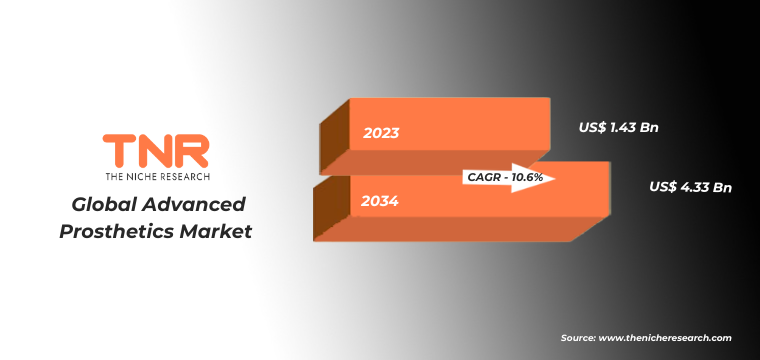
Global Advanced Prosthetics Market Dynamics
Trends-
- Integration of AI in Prosthetics: Advanced prosthetics are increasingly integrating artificial intelligence (AI) to enable more intuitive movement control. For example, Össur introduced AI-driven bionic prosthetics in 2021, allowing users to adapt their movements in real-time based on their environment.
- Rise of 3D-Printed Prosthetics: The adoption of 3D printing in prosthetics is gaining momentum, reducing production costs and enhancing customization. In 2022, Unlimited Tomorrow launched affordable 3D-printed bionic arms, offering a personalized fit and functionality tailored to individual needs at a lower cost.
Opportunities-
- Expansion in Emerging Markets: Emerging markets like India and Brazil offer significant growth potential for advanced prosthetics. In 2023, companies like Ottobock expanded operations in these regions to cater to rising demand for affordable prosthetic solutions, driven by increased healthcare access.
- Development of Lightweight Prosthetics: There is an opportunity to develop more lightweight and durable prosthetics. For example, in 2022, Blatchford introduced a carbon fiber-based prosthetic leg, improving user comfort and mobility while reducing fatigue, addressing a key user need for daily use.
Cost Result of Time To Prosthesis:
The cost result of time to prosthesis significantly impacts both patients and healthcare systems. Delays in providing prosthetic devices can lead to prolonged recovery times and increased overall costs due to extended rehabilitation and ongoing medical care. For example, studies show that a delay of just a few months in fitting a prosthesis can lead to additional expenses of up to 20% in rehabilitation costs.
Furthermore, patients may experience diminished quality of life and reduced mobility, which can result in additional psychological and social costs. Efficient and timely delivery of prosthetic devices is crucial for minimizing these costs and optimizing patient outcomes.
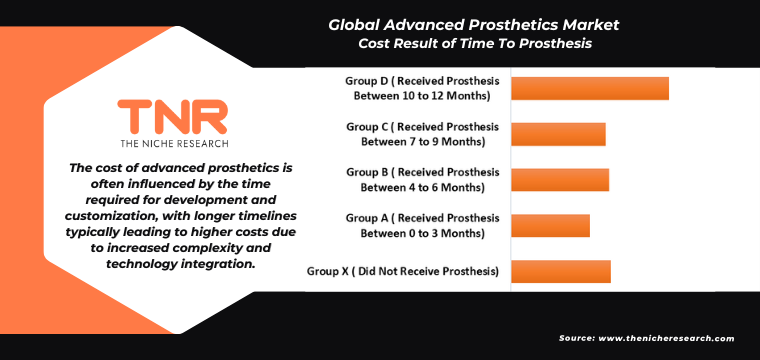
Global Advanced Prosthetics Market Revenue & Forecast, (US$ Million), 2016 – 2034
Global Advanced Prosthetics Market By Product Type
Upper extremity prosthetics segment emerged as the second-largest growing category in the global advanced prosthetics market, capturing a 32.7% revenue share in 2023. These prosthetics, including bionic arms and hands, cater to amputees seeking improved hand and arm functionality. A notable example is the Bebionic hand by Ottobock, launched in 2022, which allows users to perform precise movements such as gripping objects and typing. The increasing demand for sophisticated prosthetic solutions that mimic natural hand movements, coupled with advancements in sensor and AI technology, has driven the rapid growth of this market segment.
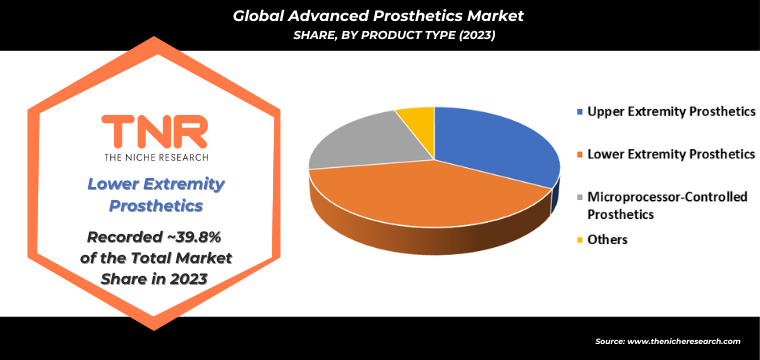
Global Advanced Prosthetics Market By Technology
Electric advanced prosthetics have become increasingly popular due to their ability to provide greater functionality and more natural movement than traditional prosthetics. These devices, powered by batteries and controlled by myoelectric signals from the user’s muscles, are expected to dominate the global advanced prosthetics market, capturing 42.8% of the revenue share in 2023. A notable example is Össur’s Proprio Foot, launched in 2021, which offers intelligent movement adjustments for walking on uneven terrain. The demand for electric prosthetics is driven by the enhanced user experience, improved control, and the ability to perform complex tasks, positioning them as a leader in the prosthetics industry.
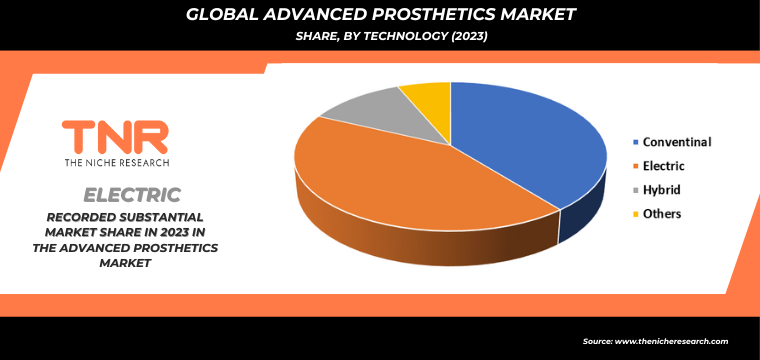
Global Advanced Prosthetics Market By End User
Prosthetic clinics dominated the global advanced prosthetics market in 2023, with a revenue share of 27.3%. These clinics specialize in fitting, adjusting, and customizing prosthetic devices to meet the unique needs of each patient. For example, Hanger Clinic, a leading provider of prosthetic care, played a crucial role in this market dominance by offering comprehensive rehabilitation services and cutting-edge prosthetics. In 2022, the clinic expanded its services to include bionic limb fittings, enabling users to achieve greater mobility and comfort. The rise in patient-specific care and growing demand for advanced prosthetics has reinforced the prominence of these specialized clinics.

Global Advanced Prosthetics Market By Region
Latin America is anticipated as the fastest growing region during the forecast timeline. This growth is driven by improved healthcare infrastructure and increased accessibility to advanced medical devices. Countries like Brazil and Mexico are witnessing rising demand for prosthetic solutions, especially after government initiatives supporting affordable healthcare. For instance, in 2022, Ottobock expanded its presence in Brazil, providing high-quality prosthetics to underserved regions. With an increasing number of limb amputations due to accidents and diabetes, coupled with advancements in technology, the Latin American market is set to experience significant growth in the coming years.
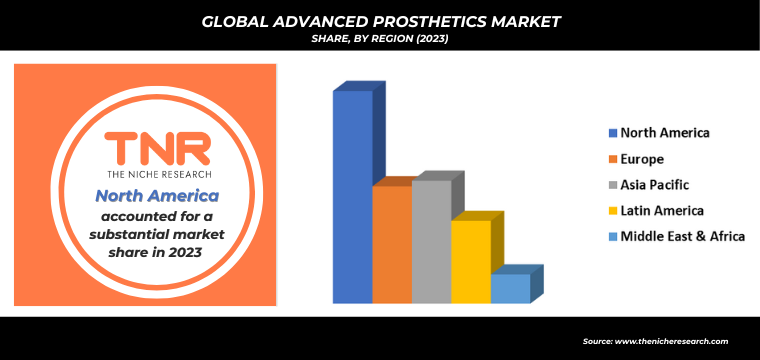
Competitive Landscape
The global Advanced Prosthetics Market is highly competitive, featuring major players like Philips, Fitbit, and Rhythm. These companies drive innovation with advanced products such as smart mattresses and sleep apnea devices. Competition is intensified by technological advancements and the growing demand for personalized sleep solutions. Market leaders focus on research and development to enhance product offerings, address diverse consumer needs, and maintain their competitive edge.
Some of the players operating in the advanced prosthetics market are
- Blatchford Group
- College Park Industries
- Endolite
- Espire Elbow
- Fillauer
- Freedom Innovations
- Ottobock
- Proteor
- RSL Steeper
- Steeper Group
- Touch Bionics
- WillowWood
- Other Industry Participants
Key Development:
- In May 2024, Psyonic collaborated with EastPoint Prosthetics & Orthotics to deliver cutting-edge bionic limbs to amputees.
- In 2023, Ottobock launched the Genium X3, featuring improved water resistance and enhanced mobility for amputees, catering to an active lifestyle.
Global Advanced Prosthetics Market Scope:
| Report Specifications | Details |
| Market Revenue in 2023 | US$ 1.43 Bn |
| Market Size Forecast by 2034 | US$ 4.33 Bn |
| Growth Rate (CAGR) | 10.6% |
| Historic Data | 2016 – 2022 |
| Base Year for Estimation | 2023 |
| Forecast Period | 2024 – 2034 |
| Report Inclusions | Market Size & Estimates, Market Dynamics, Competitive Scenario, Trends, Growth Factors, Market Determinants, Key Investment Segmentation, Product/Service/Solutions Benchmarking |
| Segments Covered | By Product Type, By Technology, By End User, By Region |
| Regions Covered | North America, Europe, Asia Pacific, Middle East & Africa, Latin America |
| Countries Covered | U.S., Canada, Mexico, Rest of North America, France, The UK, Spain, Germany, Italy, Nordic Countries (Denmark, Finland, Iceland, Sweden, Norway), Benelux Union (Belgium, The Netherlands, Luxembourg), Rest of Europe, China, Japan, India, New Zealand, Australia, South Korea, Southeast Asia (Indonesia, Thailand, Malaysia, Singapore, Rest of Southeast Asia), Rest of Asia Pacific, Saudi Arabia, UAE, Egypt, Kuwait, South Africa, Rest of Middle East & Africa, Brazil, Argentina, Rest of Latin America |
| Key Players | Blatchford Group, College Park Industries, Endolite, Espire Elbow, Fillauer, Freedom Innovations, Ottobock, Proteor, RSL Steeper, Steeper Group, Touch Bionics, WillowWood |
| Customization Scope | Customization allows for the inclusion/modification of content pertaining to geographical regions, countries, and specific market segments. |
| Pricing & Procurement Options | Explore purchase options tailored to your specific research requirements |
| Contact Details | Consult With Our Expert
Japan (Toll-Free): +81 663-386-8111 South Korea (Toll-Free): +82-808- 703-126 Saudi Arabia (Toll-Free): +966 800-850-1643 United Kingdom: +44 753-710-5080 United States: +1 302-232-5106 E-mail: askanexpert@thenicheresearch.com
|
Global Advanced Prosthetics Market
By Product Type
- Upper Extremity Prosthetics
- Hand Prosthetics
- Elbow Prosthetics
- Shoulder Prosthetics
- Lower Extremity Prosthetics
- Foot Prosthetics
- Knee Prosthetics
- Hip Prosthetics
- Microprocessor-Controlled Prosthetics
- Bionic Arms and Legs
- Robotic Hands
- Others
By Technology
- Conventional
- Electric
- Hybrid
- Others
By End User
- Hospitals
- Prosthetic Clinics
- Rehabilitation Centers
- Homecare Settings
- Others
By Region
- North America (U.S., Canada, Mexico, Rest of North America)
- Europe (France, The UK, Spain, Germany, Italy, Nordic Countries (Denmark, Finland, Iceland, Sweden, Norway), Benelux Union (Belgium, The Netherlands, Luxembourg), Rest of Europe)
- Asia Pacific (China, Japan, India, New Zealand, Australia, South Korea, Southeast Asia (Indonesia, Thailand, Malaysia, Singapore, Rest of Southeast Asia), Rest of Asia Pacific)
- Middle East & Africa (Saudi Arabia, UAE, Egypt, Kuwait, South Africa, Rest of Middle East & Africa)
- Latin America (Brazil, Argentina, Rest of Latin America)
Report Layout:
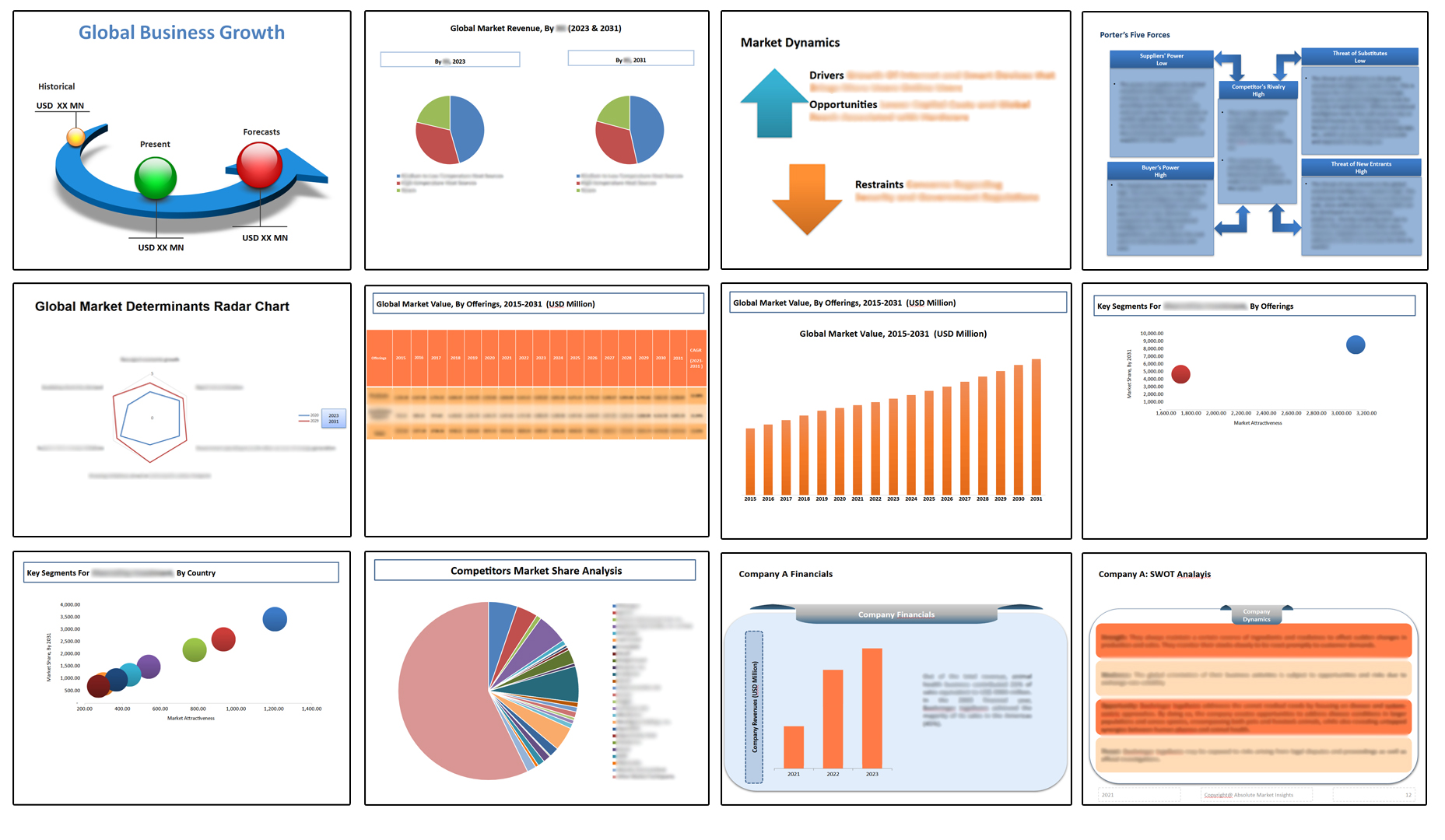
Table of Contents
Note: This ToC is tentative and can be changed according to the research study conducted during the course of report completion.
**Exclusive for Multi-User and Enterprise User.
Global Advanced Prosthetics Market
By Product Type
- Upper Extremity Prosthetics
- Hand Prosthetics
- Elbow Prosthetics
- Shoulder Prosthetics
- Lower Extremity Prosthetics
- Foot Prosthetics
- Knee Prosthetics
- Hip Prosthetics
- Microprocessor-Controlled Prosthetics
- Bionic Arms and Legs
- Robotic Hands
- Others
By Technology
- Conventional
- Electric
- Hybrid
- Others
By End User
- Hospitals
- Prosthetic Clinics
- Rehabilitation Centers
- Homecare Settings
- Others
By Region
- North America (U.S., Canada, Mexico, Rest of North America)
- Europe (France, The UK, Spain, Germany, Italy, Nordic Countries (Denmark, Finland, Iceland, Sweden, Norway), Benelux Union (Belgium, The Netherlands, Luxembourg), Rest of Europe)
- Asia Pacific (China, Japan, India, New Zealand, Australia, South Korea, Southeast Asia (Indonesia, Thailand, Malaysia, Singapore, Rest of Southeast Asia), Rest of Asia Pacific)
- Middle East & Africa (Saudi Arabia, UAE, Egypt, Kuwait, South Africa, Rest of Middle East & Africa)
- Latin America (Brazil, Argentina, Rest of Latin America)
The Niche Research approach encompasses both primary and secondary research methods to provide comprehensive insights. While primary research is the cornerstone of our studies, we also incorporate secondary research sources such as company annual reports, premium industry databases, press releases, industry journals, and white papers.
Within our primary research, we actively engage with various industry stakeholders, conducting paid interviews and surveys. Our meticulous analysis extends to every market participant in major countries, allowing us to thoroughly examine their portfolios, calculate market shares, and segment revenues.
Our data collection primarily focuses on individual countries within our research scope, enabling us to estimate regional market sizes. Typically, we employ a bottom-up approach, meticulously tracking trends in different countries. We analyze growth drivers, constraints, technological innovations, and opportunities for each country, ultimately arriving at regional figures.Our process begins by examining the growth prospects of each country. Building upon these insights, we project growth and trends for the entire region. Finally, we utilize our proprietary model to refine estimations and forecasts.
Our data validation standards are integral to ensuring the reliability and accuracy of our research findings. Here’s a breakdown of our data validation processes and the stakeholders we engage with during our primary research:
- Supply Side Analysis: We initiate a supply side analysis by directly contacting market participants, through telephonic interviews and questionnaires containing both open-ended and close-ended questions. We gather information on their portfolios, segment revenues, developments, and growth strategies.
- Demand Side Analysis: To gain insights into adoption trends and consumer preferences, we reach out to target customers and users (non-vendors). This information forms a vital part of the qualitative analysis section of our reports, covering market dynamics, adoption trends, consumer behavior, spending patterns, and other related aspects.
- Consultant Insights: We tap into the expertise of our partner consultants from around the world to obtain their unique viewpoints and perspectives. Their insights contribute to a well-rounded understanding of the markets under investigation.
- In-House Validation: To ensure data accuracy and reliability, we conduct cross-validation of data points and information through our in-house team of consultants and utilize advanced data modeling tools for thorough verification.
The forecasts we provide are based on a comprehensive assessment of various factors, including:
- Market Trends and Past Performance (Last Five Years): We accurately analyze market trends and performance data from preceding five years to identify historical patterns and understand the market’s evolution.
- Historical Performance and Growth of Market Participants: We assess the historical performance and growth trajectories of key market participants. This analysis provides insights into the competitive landscape and individual company strategies.
- Market Determinants Impact Analysis (Next Eight Years): We conduct a rigorous analysis of the factors that are projected to influence the market over the next eight years. This includes assessing both internal and external determinants that can shape market dynamics.
- Drivers and Challenges for the Forecast Period:Identify the factors expected to drive market growth during the forecast period, as well as the challenges that the industry may face. This analysis aids in deriving an accurate growth rate projection.
- New Acquisitions, Collaborations, or Partnerships: We keep a close watch on any new acquisitions, collaborations, or partnerships within the industry. These developments can have a significant impact on market dynamics and competitiveness.
- Macro and Micro Factors Analysis:A thorough examination of both macro-level factors (e.g., economic trends, regulatory changes) and micro-level factors (e.g., technological advancements, consumer preferences) that may influence the market during the forecast period.
- End-User Sentiment Analysis: To understand the market from the end-user perspective, we conduct sentiment analysis. This involves assessing the sentiment, preferences, and feedback of the end-users, which can provide valuable insights into market trends.
- Perspective of Primary Participants: Insights gathered directly from primary research participants play a crucial role in shaping our forecasts. Their perspectives and experiences provide valuable qualitative data.
- Year-on-Year Growth Trend: We utilize a year-on-year growth trend based on historical market growth and expected future trends. This helps in formulating our growth projections, aligning them with the market’s historical performance.
Research process adopted by TNR involves multiple stages, including data collection, validation, quality checks, and presentation. It’s crucial that the data and information we provide add value to your existing market understanding and expertise. We have also established partnerships with business consulting, research, and survey organizations across regions and globally to collaborate on regional analysis and data validation, ensuring the highest level of accuracy and reliability in our reports.









